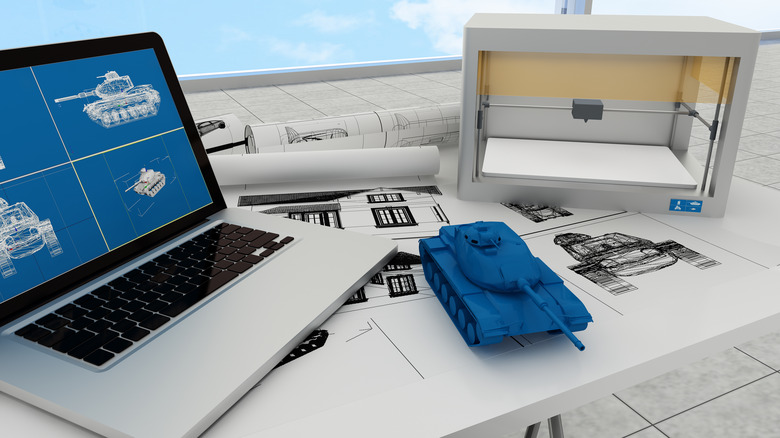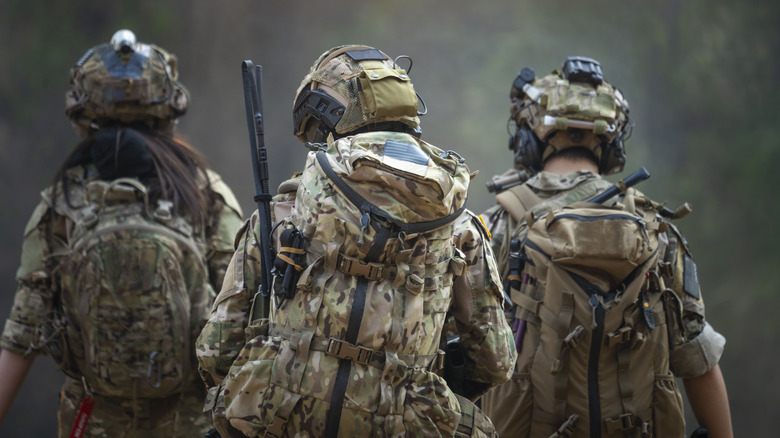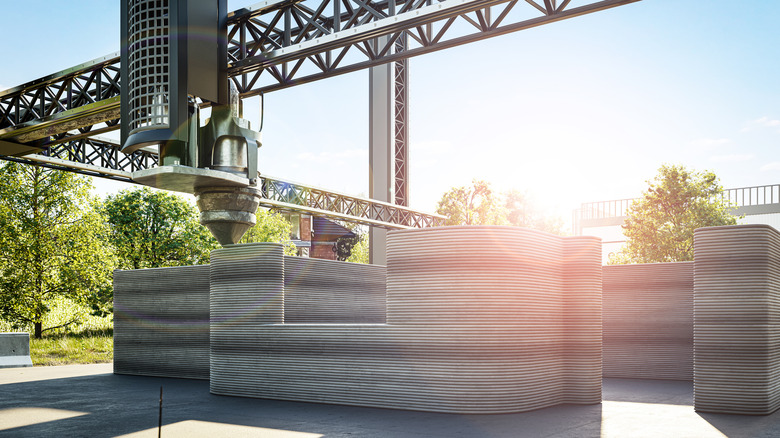4 Ways The US Military Is Using 3D Printing Technology
3D printing has been a major leap forward in technology, allowing the creation of products with the press of a button. While hobbyists have definitely taken advantage of 3D printing to manufacture costumes and collectibles with something like a beginner-level Anycubic Photon M3 printer, professionals have been able to leverage it to cut costs, labor, and project's completion time. It's not just civilians benefiting from 3D printing. The Department of Defense refers to it as additive manufacturing, but the U.S. military is taking advantage of this technology in a number of ways. The Pentagon and every branch of the U.S. military is so invested in 3D printing that they're even developing larger than average printers.
The U.S. Army is making strides in improving 3D printing technology, creating the world's largest metal 3D printer. It can manufacture hulls for ground vehicles left and right, potentially cutting production time in half. The U.S. DEVCOM Army Ground Vehicle Systems Center (GVSC) started the Jointless Hull Project in 2021. This project is being coordinated and led by prime contractor ASTRO America with several other subcontractors. Edward Flinn, director of the Advanced Manufacturing Center of Excellence at RIA-JMTC said (via U.S. Army), "[The technology] opens up the aperture of our capabilities."
Building vehicle parts is just one use for additive manufacturing in the military. According to Forbes, in 2022, the Defense Department wrote a report that recommended the military expand on its use of additive manufacturing because of how useful of a tool it is. Here are the many ways 3D printing is helping the United States military.
Keeping up with supply chain demands
Whenever there's a supply chain shortage, it's 3D printing the U.S. military turns to in order to keep operations running smoothly. When there's any kind of shortage, it can hold plans back and when that happens in the military, that could be the difference between life and death. There's a little device that gets mounted on vehicles that help soldiers see in low-light conditions called a hatch plug. The Army found themselves in a shortage in 2020 due to the manufacturer discontinuing it.
In order to get a replacement order up and running with a different vendor, it would have taken three months and $10,000. With 3D printing, though, it took a couple of days at a fraction of the cost and the Army was able to print two versions of the hatch plug. In 2022, the U.S. Navy initiated a program that paired suppliers of submarine components struggling to meet demands with 3D printing companies to keep supply chains running smoothly.
Of course, these 3D printing companies needed to be able to print with metal, otherwise the subs' integrity wouldn't hold. This is beneficial for submarine contractors by allowing them to share different workloads with another company. Many submarine contractors are the sole source of various components, which can add a lot of pressure when there are deadlines for new submarines on the books.
Obsolete parts don't have to be obsolete
Sometimes there are components in an aircraft or vehicle that manufacturers replace with more efficient parts, or the entire vehicle isn't made anymore. Every branch of the U.S. military faces issues with legacy components, and it can lead to delays in objectives timetable as well as inflated costs. The Defense Department has looked for methods to make this problem obsolete itself, and it looks like 3D printing is the best solution. It's not uncommon for the Air Force Lifecycle Management Center (AFLCMC) to use a 3D printer for parts found in older aircraft, including B-52s, C-5M Super Galaxy, and even the B-2 Spirit (the stealth bomber).
The Air Force has been leveraging 3D printing for years and is now exploring methods that will increase the hardware's durability while simultaneously decreasing its weight, which could lead to better fuel economy for its aircraft. The U.S. Navy and Naval Sea Systems Command (NAVSEA) started looking into additive manufacturing for not only obsolete parts, but also the ability to print these parts on a vessel that's at sea. Robert C. Byrd Institute (RCBI) at Marshall University virtually taught sailors aboard the USS Tulsa to set up, operate, and maintain 3D printers, giving them the skills to build components on-demand rather than waiting to return to port or a supply drop.
Create lighter equipment
Soldiers and Marines have to regularly trek long distances across tumultuous terrain in any weather, and it's not uncommon for them to do this carrying hundreds of pounds of gear. Sure, this can arguably make a person a stronger physically and mentally, but it more likely tires them out before they've reached their destination. Nobody is good to anybody dripping sweat and breathing heavy. By 3D printing certain components, the military can lighten their load, letting them trek those same distances at a quicker rate with more energy in reserve.
The Army Research Laboratory has partnered up with the University of Central Florida to improve the additive the military uses in its 3D printers. The goal of this partnership is to eventually manufacture lightweight mission components that U.S. Army soldiers use in the field. It's not just field equipment used by the boots on the ground being lightened. The Research Laboratory is also developing lightweight vehicle components, such as brackets, propulsion systems, weapons, and turret components. The Army's Next-Gen Combat Vehicles (NGVC) program is exploring titanium and other lightweight metals to use as additive.
Barracks and other structures
The Marine Corps has access to heavy-duty 3D printers significantly larger than something like the Bambu Lab X1-Carbon Combo printer that can use quick-drying cement to "print" bunkers large enough to contain a truck-mounted multiple rocket launcher system. Moreover, this construction-grade printer can build these bunkers in under 36 hours. It would depend on the size of the bunker, but using conventional means, it could take two days or more to build a bunker large enough for a single family. The Defense Department partnered with private businesses in 2022 and used similar technology to build three transient training barracks that are each more than 5,700 square feet.
Army Lt. Gen. Doug Gabram, commander of U.S. Army Installation Management Command said (via Defense.gov), "Constructing facilities using this cutting-edge technology saves labor costs, reduces planning time, and increases the speed of construction of future facilities." The material used in the construction process is proprietary to ICON, the construction technology company chosen for the project, called Lavacrete. It can withstand different forms of extreme weather and has the compressive strength of 2,000 to 3,500 pounds per square inch.
The U.S. Army Corps of Engineers developed a 3D printer that can be brought into the field through its Automated Construction of Expeditionary Structures program, or ACES. One of its 3D printers, known as ACES Lite, lets the Army swiftly build structures to keep personnel safe from shrapnel. The ACES Lite can connect to any concrete mixer, fits in a 20-foot container, and can be loaded up and ready to move in 45 minutes, building another gatehouse or even bunker wherever the Army needs.




